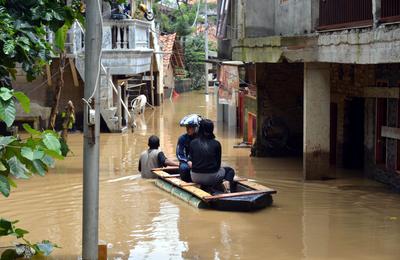Such climate events pose a threat to the economies of Southeast Asia and to ASEAN-level initiatives to promote growth, given the heavy economic losses. Damage from the 2011 floods around Bangkok was estimated at US$44 billion, while the recent Jakarta floods, according to Indonesia’s central bank, could potentially raise inflation by about 0.2 per cent.
The attention given to the economic ramifications of climate events has, however, not extended to the informal sector. Not only are people from the informal sector among the worst affected by floods, they also play an important role in supporting economic development. They form an integral element of the economies of those cities by making up 50–60 per cent of the workforce in many Southeast Asian cities.
The sector provides a range of products and services integral to urban economies including affordable food and transportation. It also plays a role in supporting companies in the formal sector and is a source of employment for the urban poor. Megacities face the challenge of having to tackle urban climate risks more generally and the vulnerabilities faced by the informal sector and the urban poor more specifically. In the wake of the 2009 Manila floods caused by Typhoon Ketsana and the 2011 Bangkok floods, the Philippines introduced new legislation to mainstream disaster risk reduction (DRR) mechanisms into climate change adaptation (CCA) measures. In Thailand, the government formulated water management and flood prevention schemes in early 2012 worth over US$9 billion. It also increased intergovernmental cooperation with countries well versed in disaster management such as Japan. However, challenges remain both at the macro level and local implementation level.
A major challenge is the need for a dramatic increase in funding. According to the Asian Development Bank, the Asia Pacific would need around US$40 billion per year up until 2050 for CCA measures. This is much higher than what is available: according to the estimates for 2009–10, only US$4.4 billion was available for adaptation activities globally. For developing countries, it would certainly need immense political will to commit the substantial amounts required.
Another concern is that while most plans currently provide for immediate disaster relief, not enough support is given to longer-term rehabilitation efforts. Megacities that seek to address climate vulnerabilities also face several implementation difficulties, especially at the local level and in addressing the specific needs of informal sector workers. The increasing frequency and intensity of typhoons has meant a narrower time frame in which to ensure that an initiative is successfully adopted or to rebuild after a disaster. In the Philippines, an average of 19 typhoons occur annually with about six to eight making landfall.
In addition, depending on the level of preparedness of an area, floods may take a considerable amount of time to subside. In the case of the floods in Thailand in July 2011 the waters did not fully subside until January 2012.
Difficulties in coordinating efforts between different government levels and agencies contribute to inefficiencies in implementation. For instance, in the Philippines, not only does the Aquino administration have to coordinate with various municipalities across Manila’s metropolitan area and factor in the high costs of infrastructure projects, it also has to deal with legal battles as a result of uncompleted flood management projects left by the previous government. Lack of coordination has also been highlighted as an issue facing the Thai government.
Lack of support from the government is another challenge. In the Philippines, the government has stalled a project for on-site in-city resettlement worth US$245 million. In Indonesia, Governor of Jakarta, Joko Widodo, had launched a similar initiative at the end of 2012 aimed at allowing riverbank dwellers to live in their current areas but in better-organised housing. However, it remains to be seen whether he will be able to overcome similar challenges on top of managing possible floods in the months ahead. That said, there may be a silver lining in the Jakarta deluge. Relevant stakeholders, such as state-owned housing developer Perum Perumnas, are progressively moving ahead with building the low-cost apartments for flood victims.
Several civil society organisations (CSOs) have taken up tasks that national or local governments have not been able to implement. By first gaining the trust of poor communities, CSOs have been able to work with them to formulate better solutions that integrate the needs of the poor into DRR and CCA programs. These efforts encompass diverse needs, including primary concerns relating to health, housing and employment.
There is also scope to implement initiatives that improve the ability of urban areas to mitigate flood disasters while also meeting the socio-economic needs of the most vulnerable sections of society. In Manila and Jakarta, improper waste disposal has resulted in clogged drainage systems, exacerbating the impact of flooding. In response, CSOs have supported community recycling projects that provide waste-pickers with jobs, thus empowering local communities.
It is important not only to protect but also empower citizens involved in Southeast Asia’s urban informal sector. To mitigate the effects of the weather-related disasters that are occurring with increasing frequency and intensity, a well-coordinated combination of technical, socio-economic and political capabilities is essential. Failure to do so will not only increase urban vulnerabilities but also result in lost opportunities to build national economies and, in turn, an economically strong Southeast Asia.
Sofiah Jamil is a PhD candidate at the Australian National University and an Adjunct Research Associate with the RSIS Centre for Non-Traditional Security Studies.
Mushahid Ali is Senior Fellow at the S. Rajaratnam School of International Studies, Nanyang Technological University.
This article first appeared here as RSIS Commentary No. 032/2013.

